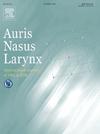Clinical characteristics and surgical indications in pediatric patulous Eustachian tube: The importance of habitual sniffing
IF 1.5
4区 医学
Q2 OTORHINOLARYNGOLOGY
引用次数: 0
Abstract
Objective
To investigate the clinical characteristics of pediatric patulous Eustachian tube (PET), with a particular focus on the presence or absence of habitual sniffing, and to assess the role of this behavior in disease severity and management.
Methods
A retrospective review was conducted of 52 patients under 18 years of age who were diagnosed with PET (definite or possible) based on the Japan Otological Society Diagnostic Criteria for PET between December 2014 and November 2024. Clinical data, including symptoms, otoscopic findings, tympanometry, and Eustachian tube function tests (TTAG and sonotubometry), were analyzed. Patients were divided into two groups based on the presence (Group A) or absence (Group B) of habitual sniffing. Surgical outcomes, including those from ventilation tube placement and Kobayashi Plug Surgery (KPS), were also evaluated.
Results
Among 1633 PET patients, 52 (3.2 %) were under 18 years of age. Voice autophony (78.9 %), breath autophony (75.0 %), and aural fullness (71.1 %) were the most common symptoms. Habitual sniffing was identified in 32 cases (61.5 %). Tympanic membrane retraction was significantly more frequent in Group A (p < 0.001). Tympanometry showed abnormal (type B or C) patterns in 42.6 % of Group A ears, while all tested ears in Group B showed type A (p < 0.0001). Eustachian tube function test results did not differ significantly between groups. Surgical intervention was required in 11 cases, of which 10 were in Group A. Post-KPS, PHI-10 scores significantly improved, although sonotubometry probe tone levels did not show statistically significant changes.
Conclusion
Pediatric PET is often associated with habitual sniffing, which correlates with abnormal tympanic findings and may necessitate surgical treatment. Assessing for habitual sniffing is essential in pediatric PET, and otoscopic and tympanometric findings are more reliable indicators of this behavior than Eustachian tube function tests. Early detection and intervention may prevent progression to retraction-type middle ear disease.
小儿扩张性咽鼓管的临床特点及手术指征:习惯性嗅探的重要性。
目的:探讨小儿扩张性咽鼓管(PET)的临床特征,特别关注是否存在习惯性嗅探,并评估这种行为在疾病严重程度和治疗中的作用。方法:回顾性分析2014年12月至2024年11月间根据日本耳科学会PET诊断标准诊断为PET(明确或可能)的52例18岁以下患者。分析临床资料,包括症状、耳镜检查结果、鼓室测量和咽鼓管功能测试(TTAG和超声管测量)。患者根据有无习惯性嗅探分为两组(A组)或无习惯性嗅探(B组)。手术结果,包括通气管放置和小林塞手术(Kobayashi Plug Surgery, KPS),也进行了评估。结果:1633例PET患者中,年龄在18岁以下的52例(3.2%)。声音自音(78.9%)、呼吸自音(75.0%)和听觉充盈(71.1%)是最常见的症状。习惯性嗅吸32例(61.5%)。A组鼓膜回缩发生率显著高于对照组(p < 0.001)。42.6%的A组耳鼓室测量异常(B型或C型),B组耳鼓室测量异常均为A型(p < 0.0001)。各组间咽鼓管功能测试结果无显著差异。11例需要手术干预,其中a组10例。kps后,pi -10评分明显提高,但超声测音探头音调水平无统计学意义变化。结论:小儿PET常与习惯性嗅探有关,这与异常的鼓室表现有关,可能需要手术治疗。评估习惯性嗅探在儿科PET中是必不可少的,耳镜和鼓室测量的结果比咽鼓管功能测试更可靠。早期发现和干预可防止发展为内陷型中耳疾病。
本文章由计算机程序翻译,如有差异,请以英文原文为准。
求助全文
约1分钟内获得全文
求助全文
来源期刊

Auris Nasus Larynx
医学-耳鼻喉科学
CiteScore
3.40
自引率
5.90%
发文量
169
审稿时长
30 days
期刊介绍:
The international journal Auris Nasus Larynx provides the opportunity for rapid, carefully reviewed publications concerning the fundamental and clinical aspects of otorhinolaryngology and related fields. This includes otology, neurotology, bronchoesophagology, laryngology, rhinology, allergology, head and neck medicine and oncologic surgery, maxillofacial and plastic surgery, audiology, speech science.
Original papers, short communications and original case reports can be submitted. Reviews on recent developments are invited regularly and Letters to the Editor commenting on papers or any aspect of Auris Nasus Larynx are welcomed.
Founded in 1973 and previously published by the Society for Promotion of International Otorhinolaryngology, the journal is now the official English-language journal of the Oto-Rhino-Laryngological Society of Japan, Inc. The aim of its new international Editorial Board is to make Auris Nasus Larynx an international forum for high quality research and clinical sciences.
 求助内容:
求助内容: 应助结果提醒方式:
应助结果提醒方式:


